
By the notion of Art, I mean a human creative activity that is of the highest importance, for it reflects, in its different disciplines, the spiritual and aesthetic concerns of a number of gifted individuals whose works have a tangible effect on the evolution of thought, on states of mind, on behaviour.
For me, art is the differential collaboration of intellect, sensibility and talent, the conjunction of rigour and poetry, free expression reduced to the essential in the aesthetic intention
22 June 1981, Walter Leblanc
Walter Leblanc
Walter Leblanc (1932 – 1986) is an important Belgian figure of European post-war art. Over the years, he has built an extremely coherent oeuvre staging light without artifice or any disrupting elements. Within the international, neo- avant-garde network of the Nouvelle Tendance, ZERO, op art, kinetic art, concrete art and (neo)constructivism, Leblanc gained both national and international recognition.
Jan Hoet described Walter Leblanc as “an artist who deserves a place in the international pantheon of art".
After graduating from The Royal Academy of Fine Arts in Antwerp, Leblanc became a founding member of the Antwerp avant-garde group G58. The exhibition ‘Anti-Peinture ‘(1962), which he curated at G58-Hessenhuis, served as his manifesto. After a figurative, abstract and subsequent monochrome period, Leblanc put the paint away for good. In 1959 he began to introduce the ‘torsion’ as an important pictorial element in his work. These torsions – made from cotton threads, plastic or metal – allowed him to bring motion, light and vibration into his reliefs and sculptures.
Leblanc actively participated in ground-breaking international exhibitions such as Monochrome Malerei (1960, Leverkusen), The Responsive Eye (1965, MoMA, New York) and Serielle Formationen (1967, Frankfurt am Main). In 1964 he won the prestigious Young Belgian Art Prize and in 1970 he took part in the 35th Venice Biennale. From 1977 until his early death in 1986, Leblanc was teaching at the Instituut voor Architectuur en Stedenbouwkunde (NHIBS) in Antwerp.
His work is part of many important museum and private art collections worldwide, such as Centre Pompidou (Paris), Tate Modern (London), Museum Kunst Palast (Düsseldorf,) Josef Albers Museum (Bottrop), Stedelijk Museum (Amsterdam), S.M.A.K. (Ghent), Mu.Zee (Ostend) and The Fine Arts Museums (Brussels).
1932
Walter François Paul Leblanc is born in Antwerp on 26 December 1932.
1949–1954
Unbeknownst to his parents, he enrols at the Royal Academy of Fine Arts, Antwerp.
In 1949–51, he studies drawing under Antoon Marstboom and at his father’s insistence, he also studies advertising under Franck Mortelmans. From 1951 to 1953, he continues to study drawing, first under Victor Dolphyn and then Carlo De Roover, and takes engraving with René De Coninck. He completes his studies at the Academy in 1954, after a final year of drawing and painting with Gustave De Bruyn, and engraving and ceramics with Olivier Strebelle.
In the evenings, he also attends classes at the School of Applied Arts: colour harmony with René Guiette, where he paints his first abstract gouache, and bookbinding with Berthe Thieren.
In the summer of 1951, he hitch-hikes with his brother to the south of France, ‘on a quest for modern painting’. The following summer, he travels to Spain with a friend.
In 1951, he meets Nicole Labedz, his future wife.
In 1951, he rents his first studio, in the Vlaaikensgang, so as to be free to experiment. He will abandon it during his military service, but later returns.
1952
He gets his first job in 1952, in the advertising department of the Automatique Électrique telephone company in Antwerp.
1954–1955
He takes part in group shows in Rotterdam, Antwerp and The Hague.
Military service sees him sent to Lombardzijde and then Bruges, where he attends an evening class in sculpture at the Royal Academy in 1955.
1956
Leblanc passed the entrance exam for the Higher Institute of Fine Arts, Antwerp, where he attends a number of classes before realizing that this is not for him. He finds the teachers’ approach too traditional and unsuited to his own interest in invention and discovery, and therefore leaves.
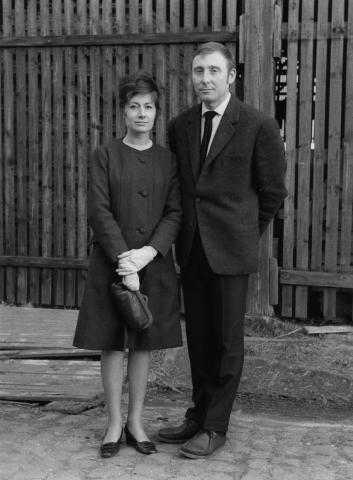
Walter marries Nicole Labedz on 28 April 1956, taking a series of jobs as a window dresser for Pan Am, a colourist at the Innovation department store in Brussels, a billboard designer for an Antwerp property company, and a sales rep for Paon Lin paints.
Flemish television regularly commissions him to create title sequences for its programmes.
He also takes part in the Young Belgian Painting exhibition at the Palais des Beaux-Arts, Brussels.
In his paintings, he replaces oil paint with texture: sand, fabric, nylon, tin lids, and sticks… It is these miscellaneous materials, not paint, that generate contrast. Paint is used only to repeat a schema or form. The work becomes less and less figurative, while also moving towards the monochrome. Colour in fact loses its value as a specific component, and is replaced in this respect by light.
1957
He has his first solo shows at Galerie Accent, Antwerp in October and then at Galerie Gérard Mourgue, Paris, in November. From time to time he manages to buy 78s by ‘the inventors of the new jazz’, who for him are Charlie Parker, Gerry Mulligan and Miles Davis.
He uses twisted thread as a textural element for the first time.
Reducing colour to the role of a unifying element also implies the need to reduce the various incorporated materials to a structural role.
1958
Leblanc is involved in setting up the G58 group in Antwerp, with Paul Van Hoeydonck, Marc Callewaert (president), and Jan Gloudemans (secretary).
G58 was founded in reaction to Brussels’ Expo ’58, whose overview of 50 years of Belgian art had failed to include the younger generation.
Thanks to the support of the mayor, Lode Craeybeckx, G58 is given a building, the Hessenhuis, which opens with an exhibition by the group on 29 November 1958.
Music, particularly jazz, is a big influence on Leblanc’s artistic reflections: ‘the interpretation on a theme, going from the heteroclitic to the homogeneous, first monochrome (the standardization of forms and colours), and from materialization to dematerialization.’ Walter Leblanc, 1981
His painting develops towards sparseness and simplification.
He creates a series of abstract ‘Gouaches’, consisting of thread glued or sewn onto cardboard, and then the ‘Gouaches Relief Sable’ (Sand Relief Gouaches), all monochromes. The latter were sometimes perforated, but more with the aim of giving expression to the non-material, than any form of spatialism.
Walter continues his research on the torsion as a structural element, working on scale and regularity. He attempts to control the behaviour of the torsions, which proves impossible with the ‘Twisted Strings’. In his experiments, he therefore replaces the thread with strips of paper, fabric, plastic or metal.
1959
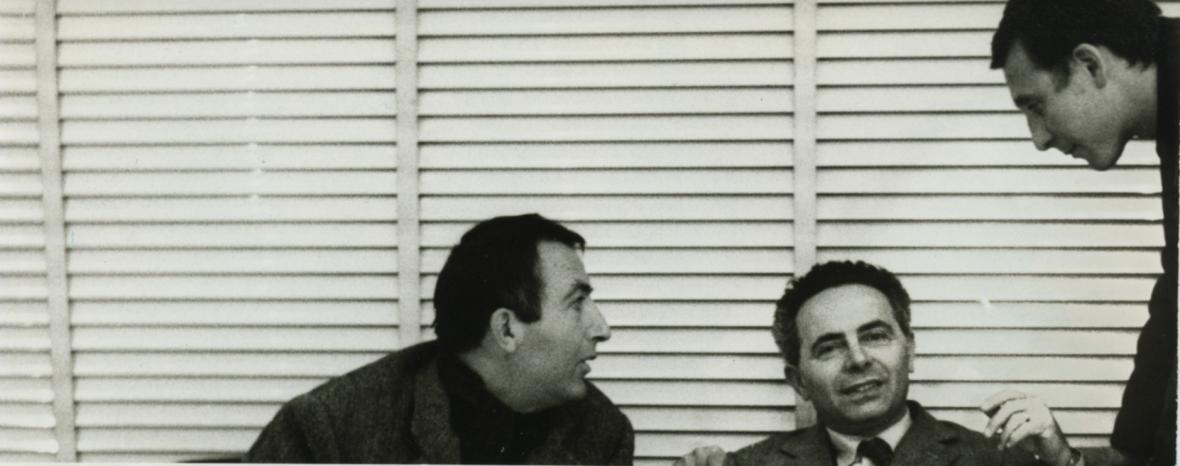
He takes part in the G58 group exhibitions and shows monochrome white, black, silver and gold Torsions on canvas at the Jeune Peinture Belge exhibition at the Palais des Beaux-Arts, Brussels.
He is selected for the second Prix Suisse for Abstract Painting exhibition at Galerie Kasper in Lausanne.
He has four solo shows: at the Hessenhuis (Antwerp) in March, De Toonkelder (Leuven) in April, and at the Galerie Breckpot Jeune (Antwerp) and Galleria Pater (Milan), both in May.
His work enters the Etzold collection.
‘My goal had been achieved: uniformity of structure, and uniformity of the materials employed’ Walter Leblanc, ‘L’évolution’, 1981.
He considers his ‘Twisted Strings’ to be his first properly uniform works.
‘In 1958, the first serial signs appeared in my work. In 1959 these took their definitive form. From then on, the development of my work has been devoted to the different modes of expression for this starting point; it is based upon the interrelationship of the component elements of the ensembles’. Walter Leblanc, s.d.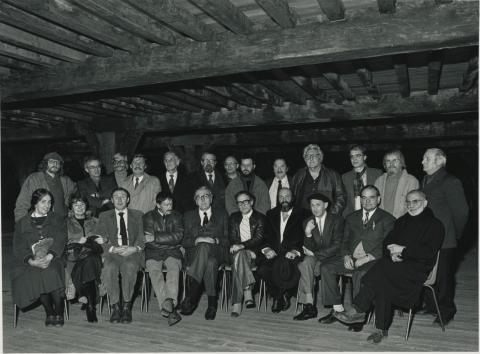
The range and variety of his thinking is reflected in the constitution of his programmes. These initially involve informal structures or focus on lines of force (parallel, convergent or radiating), simple forms or grouped forms, but then develop towards the 1970s into programmes of permutation, constitution and evolution.
1960
Three solo shows: Galerie Breckpot Jeune (Antwerp) in June, Deutscher Bücherbund (Bonn) in November, and Antwerpse Discoteek (Antwerp) in December.
Invited by Udo Kultermann, he also takes part in the first international monochrome retrospective, Monochrome Malerei (March–May, Städtisches Museum, Leverkusen), representing Belgium alongside Jeff Verheyen, Paul Van Hoeydonck and Mark Verstockt.
He is also a finalist in the City of Ostend’s European Prize for Painting.
Walter joins the Nouvelle École Européenne group organized by Georges Kasper.
In October, he is involved once again in the Swiss Prize for Abstract Painting exhibition at Galerie Kasper in Lausanne, and
at the end of the year, he takes part in the Nouvelle école européenne exhibition at the Hessenhuis, which is later shown at the Galerie Kasper (Lausanne) in June 1961.
Leblanc produces his first ‘Mobilo Statics’, which he describes as his second series of uniform works.
These are compositions structured by twisted strips of PVC, which at last affords the rigorous control of helicoidal movement.
These works invite exploration of the depth of the work and of the viewer’s own movement. They can be transparent, multi-coloured or monochrome, cut into in parts, or animated throughout by torsions.
1961
Leblanc takes part in a collaboration with Iris Clert and the Galerie le Fleuve in Paris, and meets Michel Seuphor in connection with the writing of the latter’s La peinture abstraite, sa genèse, son expansion.
He is selected as a finalist in Ostend’s European Prize for Painting, which also sees him invited to take part in a prizewinners’ exhibition at the APIAW, in Liège, in January 1962.
In April, his first major solo exhibition takes place at the Palais des Beaux-Arts, Brussels.
Leblanc travels to Spain, where he makes contact with Hernandez Pijuan in connection with preparations for an exhibition of four Spanish painters at the Hessenhuis. He also meets the critic Juan Eduardo Circlot, who writes an article on his work for the Correo de las Artes.
He creates the title sequence for an art programme on BRT.
Attending the exhibition Internationale Malerei 1960–61 at Galerie 59 in Wolframs-Eschenbach, Leblanc plans a collaborative project for G58 with gallery director Heiner Ruths.
Leblanc’s solo show at the Galerie Rottloff, Karlsruhe, meets with a certain success.
In August, following the resignation of Marc Callewaert, Leblanc succeeds him as president of G58 and is joined on the committee by his friend, the photographer Filip Tas, the poet Jan Gloudemans, and the technician Francis Lauwers.
1962
After a tough start, there is at last a degree of public recognition.
He has two solo shows in Switzerland in February, at Galerie Toni Brechbühl in Grenchen (Canton of Solothurn) and at Galerie Beno in Zürich, thanks to Balz Hilt, with whom Leblanc has become friends after meeting him in 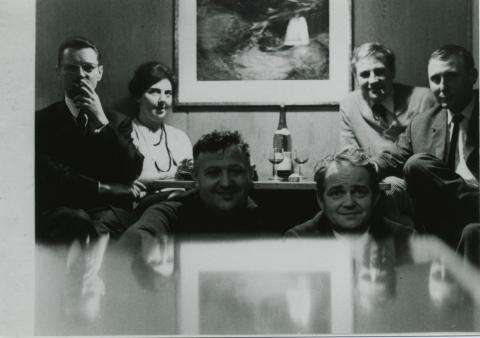 Lausanne. He will go on to represent the artist in Switzerland.
Lausanne. He will go on to represent the artist in Switzerland.
Leblanc takes part in the Jeune Peinture Belge exhibition.
March–April: Leblanc curates the Anti-Peinture exhibition at the Hessenhuis, featuring 80 works by 46 international artists.
The G58 group dissolves.
Leblanc participates in the international exhibition Forum 62 at St Peter’s Abbey in Ghent, where he meets gallerist Peter Tunnard who will exhibit him in 1964.
He also takes part in Neue Tendenzen 62, Zero, an exhibition of small-format works at the Galerie Schindler in Bern.
He features in the European Prize for Painting exhibition in Ostend and
meets George Rickey at the opening of the latter’s show at Galerie Anna Roepcke, Wiesbaden. Having already taken an interest Leblanc’s work at the Galerie Schindler show, Rickey will include the artist in his book Constructivism, published in 1967.
1963
Leblanc is runner-up in the Prix de la Jeune Peinture Belge, and the Belgian government buys one of his pieces.
He has two solo exhibitions: at Galerie Le Zodiaque (Brussels) and at Galerie Ad Libitum (Antwerp), which wins him the Critics’ Prize.
He exhibits once again at St Peter’s Abbey in Ghent as part of Forum 63 and is
invited to show at the San Marino Biennale, together with Belgian artists Alechinsky, Bury and Swimberghe.
Leblanc also participates in the exhibition Europaïsche Avantgarde curated by William E. Simmat at Galerie d in Frankfurt, and at Mikro, an exhibition of small-format works organized by Toni Brechbühl in Grenchen.
Thanks to Getulio Alviani and Matko Mestrovic, Leblanc shows as part of Nuova Tendenza 2 in Venice, an exhibition that is also shown in Leverkusen the following year.
Leblanc works on a series on the theme of the ‘Torsions Schématiques’. ‘The decomposition of the virtual movement of the torsion into plane surfaces, which in their positioning around an axis can either occupy space or collapse into the graphic.’ He will return to this theme the following year in the project for the Botanic Building.
1964
Leblanc embarks on a period of intense work. Time restrictions and insufficient works to meet demands mean that he has choices to make about the offers that come his way. The year also sees many encounters with artists, curators and artist-curators, including Henk Peeters, who involves Leblanc in projects he is organizing in Rotterdam, Amsterdam and Velp, and others that will remain unrealized, like Zero on Sea. Leblanc participates in no less than 20 group shows, including several at the heart of the ZERO group (New Vision Centre Gallery, London; Galerie Delta, Rotterdam; Galerie Amstel, Amsterdam) and – with his ‘Mobilo Statics’ – as a member of the New Tendencies group that champions optical and kinetic art (Städtisches Museum, Leverkusen, and the Musée des Arts Décoratifs, Paris). Supported by the Belgian government, his participation in the Paris exhibition proves a real spur to sales in Belgium; hard on its heels comes the Salon de Mai in the French capital.
Peter Tunnard, who came across Leblanc at the Forum 62 exhibition, stages a Wills, Fontana, Leblanc and Piene show in London. This is followed by the ZERO group exhibition at the New Vision Centre Gallery, London, alongside Peeters, Verheyen, Mack and others, and then, in the same city, Structures Vivantes: Mobile Images, with Agam, Bury, Fontana, Soto, Vasarely and others, which meets with great success at the Redfern Gallery.
That same year, Leblanc is among the laureates of the Prix de la Jeune Peinture Belge competition.
The Pfalzgalerie, Kaiserslautern, acquires a 'Mobilo Static' through Balz Hilt.
On the recommendation of George Rickey, William C. Seitz, curator of the Responsive Eye exhibition, visits Leblanc’s studio with a view to his inclusion.
At the end of the year, Leblanc takes part in the exhibition of artists from the Galerie Wilm Falazik in Bochum, which sees two of his works join the Klinker collection.
The artist’s works are becoming known across Europe and meeting with great success.
He travels again to Spain.
‘These two potential modes of plastic expression for the torsion (‘Twisted Strings’ and ‘Mobilo Static') are based on the programmed, serial development of a set of elements considered as a single work. From 1964 onward, the serial programming will go beyond the single painting to become correlative, that is to say the one painting no longer has meaning save in relation to one or more other paintings forming part of the same constitutive context’ Walter Leblanc, Letter to A. Rigato, 1985
Leblanc creates his first architectural installation: a 12-metre-long structure for the entrance to the Botanic Building on the Blvd. Saint Lazare in Brussels, whose architect is Henri Montois.
Leblanc creates a very large-scale 'Mobilo Static' (3.60 x 1.80 m) to show at the Musée des Arts Décoratifs in Paris. He embarks on a number of projects for architects, and produces a fifth series of screenprints, which sell exceptionally well. He contributes to the second volume of La Lune en Rodage, published by Carl Laszlo.
1965
Leblanc has five solo exhibitions of ‘Mobilo Static’ pieces, one with Suzanne Bollag in Zürich, who goes on to introduce Leblanc’s work to a number of enthusiastic American collectors and places a work with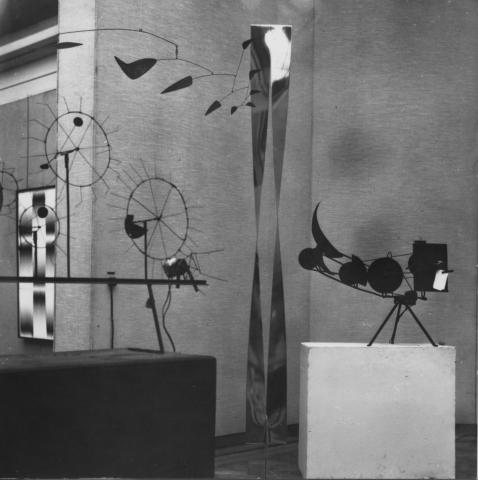 the Musée de Montréal the following year; followed by shows at Galerie 123 in Krefeld, at Hans Meyer’s Op Art Galerie in Esslingen, at the Palais des Beaux-Arts in Brussels, and finally, at Marianne Aue’s Galerie Orez in The Hague.
the Musée de Montréal the following year; followed by shows at Galerie 123 in Krefeld, at Hans Meyer’s Op Art Galerie in Esslingen, at the Palais des Beaux-Arts in Brussels, and finally, at Marianne Aue’s Galerie Orez in The Hague.
He takes part in 29 international exhibitions, including: Neue Tendenzen: Arte programmata, Anti-peinture, ZERO/Nul, and on the invitation of Christian Megert, Recherche d’art visuel, Recherche continuelle at Galerie Aktuell in Bern;
The Responsive Eye at MOMA, New York, an exhibition curated by William C. Seitz, which then travels to a number of American museums; Zero Avantgarde at Lucio Fontana’s studio in Milan; and then shows at Galleria del Cavallino in Venice, and finally Galleria il Punto in Turin.
Seven of Leblanc’s works feature in Nouvelles recherches flamandes, organized by Hans Liechti at the Musée Rath, Geneva, which ends up being the final event of the Nieuwe Vlaamse School. He also exhibits works at Licht und Bewegung – Kinetische Kunst, organized by Harald Szeeman and staged at the Kunsthalle Bern, Kunsthalle Baden-Baden, and Kunsthalle Düsseldorf.
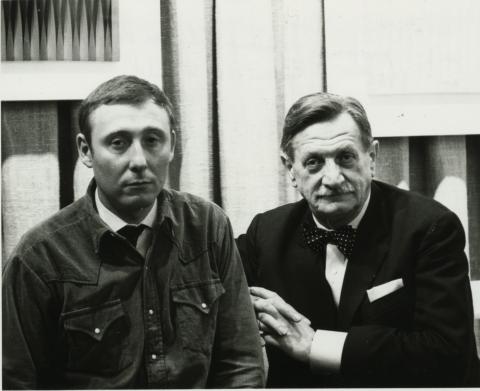 This last is followed by Lumière, mouvement et optique at the Palais des Beaux-Arts, Brussels, succeeding his 'Mobilo Static' show at the same venue.
This last is followed by Lumière, mouvement et optique at the Palais des Beaux-Arts, Brussels, succeeding his 'Mobilo Static' show at the same venue.
On the recommendation of George Rickey, Leblanc’s work is included in White on White at the De Cordova Museum of Lincoln, Massachusetts, which is also shown at the Addison Gallery of American Art, Andover, the following year.
This extremely busy year is punctuated by many trips abroad, including a month in Italy and numerous visits to Switzerland.
He creates an architectural installation for the Résidence Vincennes, 479, Avenue Louise, Brussels, built by the architect L.J. Baucher. The composition of the work can be changed by moving the blades along the nylon filaments.
1966
Leblanc has four solo exhibitions in Germany and Belgium: in Keerbergen, at Dorethea Loehr’s in Frankfurt, at Mullem, and at the Galerie Moderner Kunst der Bücherstube am Dom in Cologne, this last curated by Prof. Schulze Vellinghausen, whom the artist had met at Galerie Brechbühl. Leblanc continues to take part in group shows with artists from the international neo-avant-garde, among them Pop Op at Galerie d, Frankfurt; Weiss auf Weiss, organized by Harald Szeeman at Kunsthalle Bern; Avant-Garde Zero 1966 at Galleria Il Segno, Rome, and then at Galleria Associazione Zen, Brescia; at Halfmannshof, Gelsenkirchen, on the invitation of Ferdinand Spindel and alongside Bonalumi, Cruz-Diez, Rickey, Sommer, and Soto; and at the Salone Internazionale dei Giovani, Venice, organized by Guido Ballo.
Leblanc wins Ostend’s European Prize for Painting, which sees a work acquired for the city’s museum, while another piece is purchased by the Museum of Modern Art, Brussels.
1967
Leblanc is selected for the Critic’s Prize exhibitions of 1964–5 (Charleroi) and 1965–6 (Ghent).
He takes part in the Serielle Formationen exhibition at the Studio Galerie of the Goethe University in Frankfurt. Curated by Paul Maenz and Peter Roehr and supported by Dorothea Loer, this is the the first time that it has been possible for Leblanc’s work to be set in relation to that of the American Minimalists.
Leblanc also participates in the exhibition Vom Konstruktivismus zur Kinetik: 1917 bis 1967 at Galerie Denise René / Hans Mayer, Krefeld.
At the 5th Biennale de Paris, he is awarded a bursary of 1,200 francs to fund a three-month stay in France. An exhibition of the work of the prizewinners and the runners-up will travel to Zagreb and Belgrade the following year.
Leblanc designs an architectural installation for the lobby of the headquarters of the tram network, the SNCV, at 14, rue de la Science, Brussels.
He produces two monumental works for Farbwerke Hoechst of Frankfurt, with torsions created in Hostalit and dyed in the mass. The first five works to enter the company’s collection – by Leblanc, Goepfert, Mack, Fiebig, and Uecker – are shown at a plastics trade fair event in Düsseldorf, Internationale Kunststoffmesse Farbwerke Hoechst. Kinetische Objekte, for which Leblanc also produces the poster.
A first monograph is published.
1968
Leblanc has five solo exhibitions in 1968: at Galerie Regio, Lorrach; Kunstverein Freiburg; J. Walter Thompson Belgium, which wins him the Critics’ Prize; at the Centre International pour l’Art Contemporain, Dendermonde; and at the Palais des Beaux-Arts, Brussels. He establishes contact with Siegfried Bröse, president of Kunstverein Freiburg, who will help to promote his work. It is thanks to Toni Brechbühl that Leblanc is by now working with Galerie Regio, Lörrach, and it is at Brechbühl’s that Bröse discovers Leblanc’s work.
As in 1966, Walter takes part in the summer exhibition at Galerie Aktuell, Bern, and he contributes a work of monumentalscale to Frank Popper and Philippe Nahoum’s Cinétisme, environnement, spectacle at the Maison de la Culture, Grenoble.
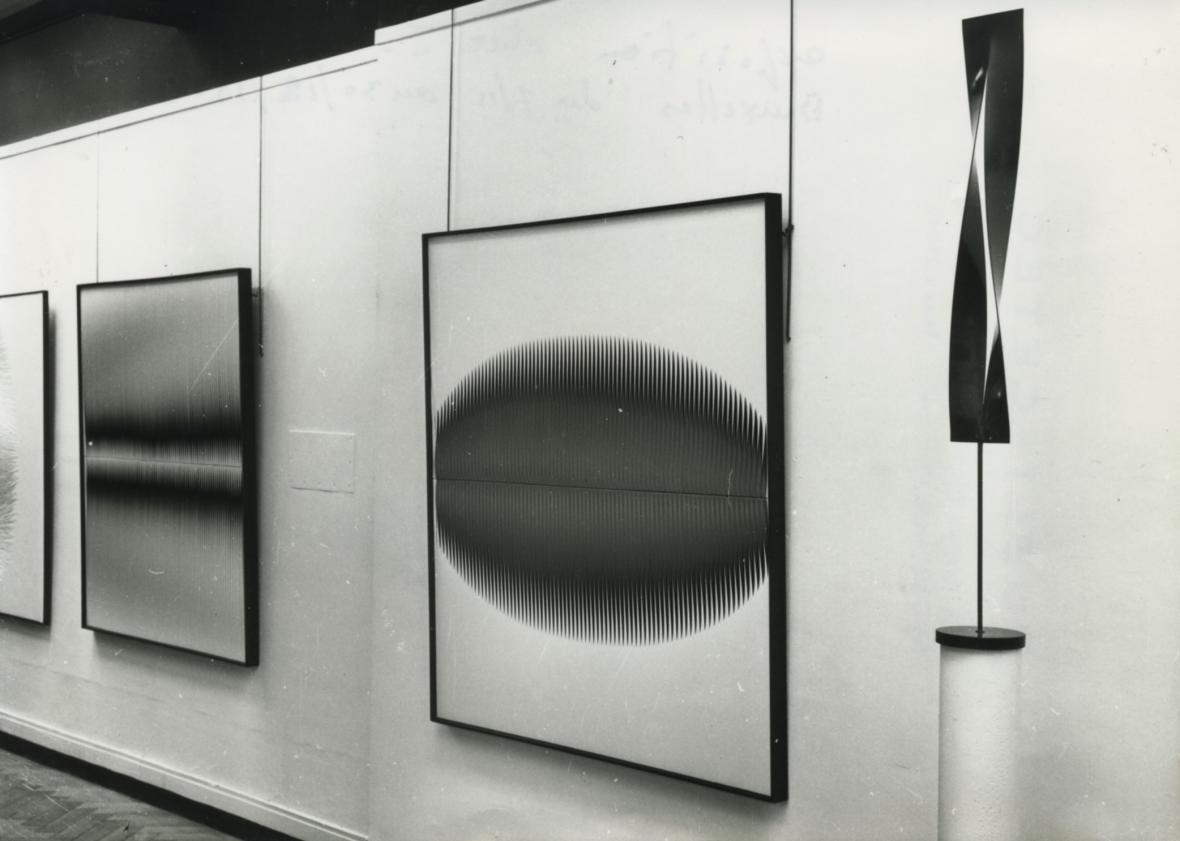
He participates in the exhibition Art construit at Le Disque Rouge gallery in Brussels, and also in the exhibition on kinetic art at the Haus am Waldsee, Berlin.
Three works are included in an exhibition of contemporary Belgian art that travels to Tehran, Baghdad and Beirut. This is organized by the art department of the Belgian Ministry of Education and Culture. The German Ministry of Culture acquires a work by Leblanc from Galerie 66, Hofheim.
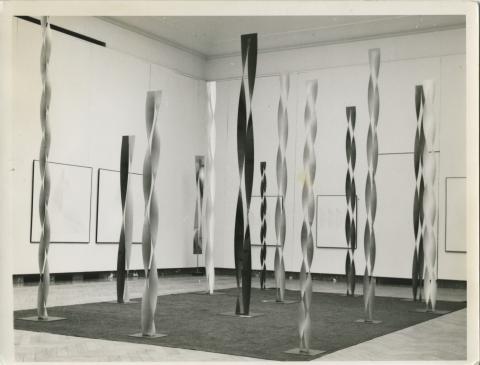 In the spring, Walter and Nicole travel to Morocco.
In the spring, Walter and Nicole travel to Morocco.
1969
The couple buy a farmhouse in Silly, in the Belgian province of Hainaut, not far from his parents’ country cottage. He works hard on renovating the property and does not exhibit very much this year. There is nonetheless a solo show at Galerie Ursula Lichter in Frankfurt. He also takes part in group shows, including Dynamo Zero – again at Lichter’s gallery – and the Biennale Konstruktive Kunst: Elemente und Prinzipien at Kunsthalle Nürnberg.
Leblanc designs an architectural installation for a building belonging to Velge & Co. in Antwerp.
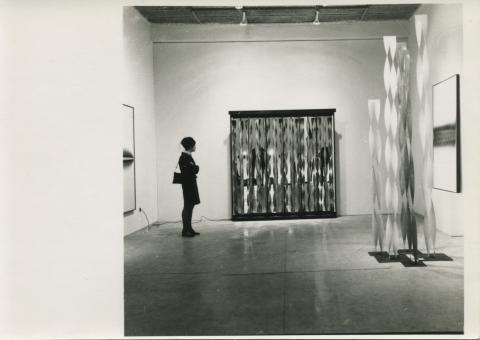
1970
Leblanc is awarded the Eugène Baie Painting Prize for 1969 by the province of Antwerp.
He has six solo exhibitions: at Le Disque Rouge, Brussels (screenprints); Galerie BC, Antwerp; Galerie m, Bochum; Suzanne Bollag, Zürich; Belgisches Haus, Cologne; and at the Musée des Beaux-Arts, Verviers.
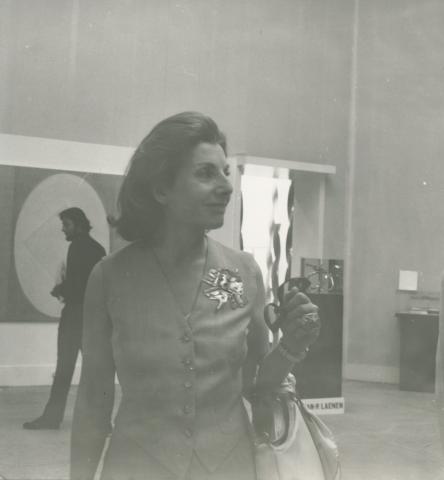 He also features in the Etzold Collection exhibition at the Kunstverein, Cologne, and
He also features in the Etzold Collection exhibition at the Kunstverein, Cologne, and
represents Belgium at the Venice Biennale, alongside Bram Bogart, Georges Collignon, Jean-Michel Folon, Jean-Paul Laenen, and Jef Verheyen. Preparations are hurried, for he is given only a month’s notice to select and produce the right works.
Leblanc meets Jean-Pierre Maury at the Belgische Kunst 1960–1970 exhibition at the Kunstverein, Cologne.
He also features in the exhibition of George Rickey’s collection of Constructivist art in New York, which goes on to tour the United States, being shown at a dozen museums between 1970 and 1972.
The screenprints published by Brechbühl and Bollag meet with great success, and Leblanc also takes part in events devoted to the medium, such as the Triennale internationale d’estampes en couleur in Grenchen.
The Belgian government acquires another piece, and works are also added to the collections of the Musée d’Ixelles.
1971
Leblanc exhibits with Bram Bogart in four Swedish cities, and in Norway, where he sells three works to the Malmö Museum.
Leblanc contributes a multiple to a publication by Alexander von Verswordt-Wallrabe of Galerie m, Bochum, with which Leblanc subsequently maintains an ongoing relationship and a regular source of sales.
Leblanc takes part in the exhibition of Constructive art at the Galerie Gmurzynska-Bargera, Cologne.
The Friends of the Musée des Beaux-Arts de Verviers acquire one of his works.
Leblanc creates an architectural installation commissioned by the architect Marcel Blomme in the form of a 10-metre-high mobile for Westland Shopping, a Brussels shopping centre.
1972
Leblanc continues to be represented by Toni Brechbühl, who shows his work at the art fairs of Cologne, Basel and Düsseldorf.
He has two solo exhibitions in Brussels, at the Disque Rouge, where he shows his 'Torsions Schématiques', and at the Miroir d’Encre. He also has a solo show at the Galerie MultiArt, Antwerp.
Leblanc works less, having seriously injured his hand on a circular saw while making frames.
Chase Manhattan Bank acquires a work for its New York headquarters.
Leblanc takes part in Herbert Distel’s Museum of Drawers project, creating a work of 5.7 x 4.8 cm which is delivered in late 1973. This project is then exhibited around the world before its 500 works are bequeathed to the Haus Konstruktiv, Zürich.
1973
Leblanc exhibits the results of his research into the torsion originally shown at the Venice Biennale at Zita Vismara’s gallery in Milan, and the screenprints of 1963 are presented at the Studio d’Arte Moderna, Rome.
The exhibition at Vismara’s is a great success and leads to other exhibition opportunities, notably in Padua in collaboration with La Chiocciola, L’Arte non oggettiva. Opere dal 1923 al 1973, in San Remo the following year and in Varazze in 1975.
Leblanc exhibits with the Galerie Suzanne Bollag at the Basel Art Fair.
The Royal Museum of Fine Arts, Antwerp stages a retrospective devoted to G58 Hessenhuis.
Two works are acquired by the Paribas Bank of Belgium.
1974
Galerie Regio gives Leblanc a solo exhibition on the occasion of the Basel Art Fair, which wins the prize awarded by that city’s chamber of commerce and again attracts the attention of the Galerie Bargera, which offers him a solo show. For this he produces a number of new works together with a screenprint.
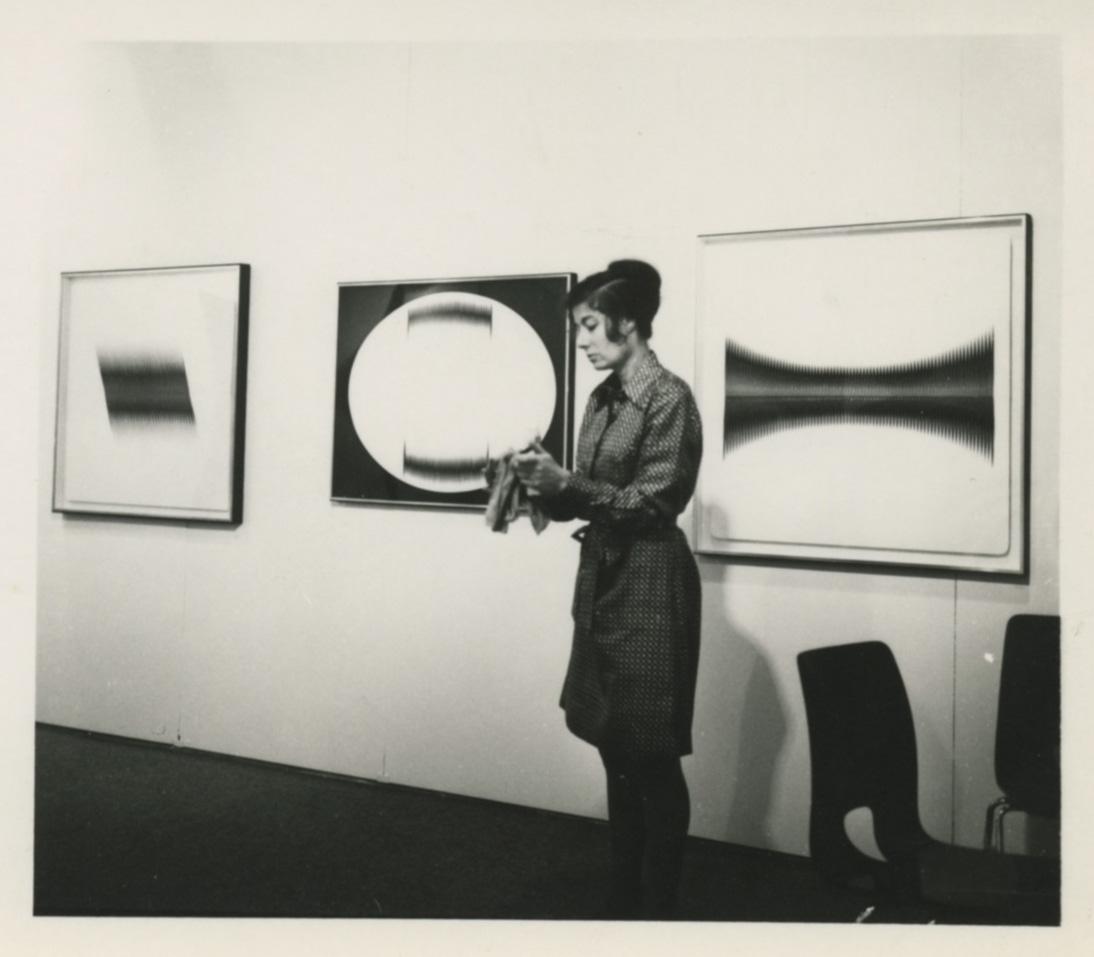
Thanks to Zita Vismara, he shows at the Galerie Beniamino, San Remo, and towards the end of the year he exhibits once again at the Miroir d’Encre, Brussels.
He also participates in group exhibitions, including Neue Konkrete Kunst – Realer Raum at Galerie m, Bochum; Belgische Beeldhouwkunst at the Middelheim Open Air Museum near Antwerp; the Kleinformatausstellung at Lydia Megert’s gallery in Bern, which is also shown at Galerie Seestrasse, Rapperswil in 1975; and Situazione estetica fine 1974 at the Vismara gallery in Milan.
Leblanc now travels less and always accompanied by his wife.
The Belgian government purchases a further work.
1975
He takes part in the Salon des réalités nouvelles in Paris and is also shown at the art fairs of Basel and Bologna.
Thanks to Zita Vismara, he is given a solo show at Baglietto’s in Varazze, and a work is acquired by the Royal Museum of Fine Arts, Antwerp.
Leblanc is appointed Chevalier of the Order of Léopold II.
Leblanc produces his first ‘Archétypes’, investigating combinations of geometrical forms (the square, the circle, the triangle, etc.)
1976
Leblanc exhibits at the art fairs of Basel and Bologna, and has a solo exhibition at Galerie Ado, Bonheiden.
He also takes part in a number of group shows, including Contradictions 76, sculpture et art cinétique at the American Center, Paris.
Leblanc embarks on his series of photograms, ‘Fréquences horizontales, Fréquences obliques’
1977
03.23.03: Premières rencontres internationales d’art contemporain takes place in Montréal and Ottawa. Leblanc sends a work to be shown alongside the one already acquired in Zürich by the Musée de Montréal.
He visits Sweden in July and has a solo exhibition at the Galerie Kirwin, Brussels in October.
Leblanc is appointed lecturer in colour at the National Higher Institute of Architecture and Urban Planning, Antwerp, where he will teach until his death.
He visits New York.
The Museum of Modern Art, Brussels, acquires a second work.
1978
There is a solo exhibition of Leblanc’s photograms at Le Disque Rouge, Brussels, and he also participates in the group exhibition 50 Belgische Kunstler aus Flandern at Kunstpalast Düsseldorf.
He spends a lot of time on the realization of very large-scale works.
Architectural installation for the Aula Major of the University of Antwerp, with Storme & Van Ranst as architects.
Architectural installation for the lobby of the Banco do Brasil, Brussels, with Paul Caulier as architect.
1979
Leblanc spends time in New York with a view to approaching galleries, and he produces a number of works there.
He spends his summer holidays in Greece with Nicole.
Leblanc takes part in group shows at the Galerie Dorothea Loer, Frankfurt; at Galerie Bargera, Cologne; and at Galerie Aturiale, Liège.
The Royal Museum of Fine Arts, Antwerp, stages a major exhibition, Zero internationaal Antwerpen.
Creates the ‘New York’ series of photogram collages.
1980
Leblanc has a solo show at Galerie Aturiale, Liège, and participates in several group shows in Belgium, including two at Le Miroir d’Encre and an exhibition on parallels and convergences in art since 1945, which is organized at the Palais des Beaux-Arts, Brussels, as part of Europalia, and later appears at the Calouste Gulbenkian Foundation in Portugal and the Boymans-Van Beuningen Museum, Rotterdam, in 1981.
Contemporary Belgian Art is staged at the Adi Gallery, San Francisco, marking 150 years of Belgian independence.
Leblanc shows with Hubertus Schoeller at the opening of his new gallery in Düsseldorf.
He also takes part in Treffpunkt Parnass 1949–1965 at the Von der Heydt Museum, Wuppertal, which will travel to Paris, Bourges, London and Edinburgh in 1982, and to Mülheim an der Ruhr in 1983.
The Royal Museum of Fine Arts, Antwerp, acquires a second work.
1981
Leblanc agrees to be represented by Hubertus Schoeller for Germany.
He takes part in two exhibitions at the Miroir d’Encre, one of which is a solo show, as well as several group exhibitions, mostly in Belgium, but also one at Galerie m in Bochum.
Leblanc’s work enters the collection of the Bank Brussels Lambert.
A set of 'Archétypes' is commissioned for the Simonis métro station in Brussels. There is also the commission of a monumental Archétype for the IBM headquarters in Antwerp.
1982
Leblanc has two solo exhibitions, at the FS Gallery in Louvain, and at the Jeanne Buytaert Gallery in Antwerp, where he shows his ‘Archétypes’.
He also exhibits in Verviers, with Francis Dusépulchre and Willy Helleweegen.
The Musée d’Ixelles acquires a second work.
1983
Leblanc participates in a group exhibition at Gemeentemuseum Den Haag; Informele Kunst in België en Nederland 1955–1960: Parallellen in de nederlandstalige literatuur will also be shown at the Royal Museum of Fine Arts, Antwerp in 1984.
Hubertus Schoeller stages Leblanc in a two-person show with Kuno Gonschior.
1984
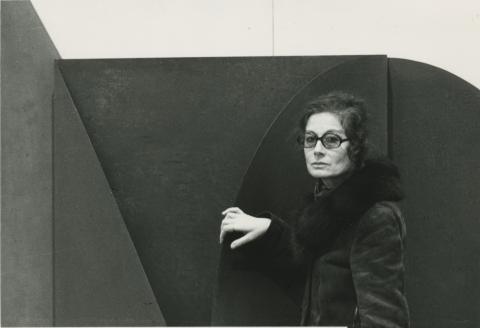 Leblanc’s works feature in a number of museum exhibitions, including: Vlamingen in Venetië at the Dhondt-Dhaenens Museum, Deurle; Géométrie de la matière at the Foundation for Contemporary Belgian Art; and Surface sculpturale at Atelier 340, Brussels, which will travel to Warsaw in 1985 and Kraków in 1986.
Leblanc’s works feature in a number of museum exhibitions, including: Vlamingen in Venetië at the Dhondt-Dhaenens Museum, Deurle; Géométrie de la matière at the Foundation for Contemporary Belgian Art; and Surface sculpturale at Atelier 340, Brussels, which will travel to Warsaw in 1985 and Kraków in 1986.
He stages a solo show with Frank Nietveld in Brasschaat.
The Province of Antwerp acquires a work.
1985
The Lenz Collection is exhibited in public for the first time at the Museum Carolino-Augusteum, Salzburg.
Walter and Nicole spend the summer on the island of Naxos in the Cyclades, Greece.
The Royal Fine Art Museum, Antwerp, acquires a third work.
Architectural installation for the lobby of the ABN Amro Bank, Brussels.
1986
On 14 January 1986, Walter Leblanc dies in a car accident while on his way to the Museum of Modern Art, Brussels to finalize the lighting for the group exhibition Rapports Plan/Espace – Tussen Vlak en Ruimte.

